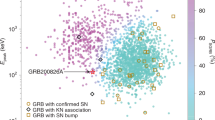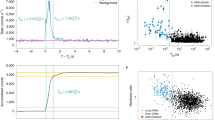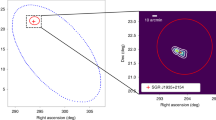Abstract
Gamma-ray bursts (GRBs) fall into two classes: short-hard and long-soft bursts1,2,3. The latter are now known to have X-ray4 and optical5 afterglows, to occur at cosmological distances6 in star-forming galaxies7, and to be associated with the explosion of massive stars8,9. In contrast, the distance scale, the energy scale and the progenitors of the short bursts have remained a mystery. Here we report the discovery of a short-hard burst whose accurate localization has led to follow-up observations that have identified the X-ray afterglow10 and (for the first time) the optical afterglow10,11 of a short-hard burst; this in turn led to the identification of the host galaxy of the burst as a late-type galaxy at z = 0.16 (ref. 10). These results show that at least some short-hard bursts occur at cosmological distances in the outskirts of galaxies, and are likely to be caused by the merging of compact binaries.
This is a preview of subscription content, access via your institution
Access options
Subscribe to this journal
Receive 51 print issues and online access
$199.00 per year
only $3.90 per issue
Buy this article
- Purchase on Springer Link
- Instant access to full article PDF
Prices may be subject to local taxes which are calculated during checkout




Similar content being viewed by others
References
Hurley, K. in Gamma-Ray Bursts (eds Paciesas, W. & Fishman, G.) 3 (AIP, New York, 1992)
Lamb, D. Q., Graziani, C. & Smith, I. Evidence for two distinct morphological classes of gamma-ray bursts from their short time scale variability. Astrophys. J. 413, L11–L14 (1993)
Kouveliotou, C. et al. Identification of two classes of gamma-ray bursts. Astrophys. J. 413, L101–L104 (1993)
Costa, E. et al. Discovery of an X-ray afterglow associated with the gamma-ray burst of 28 February 1997. Nature 387, 783–784 (1997)
van Paradijs, J. et al. Transient optical emission from the error box of the gamma-ray burst of 28 February 1997. Nature 386, 686–688 (1997)
Metzger, M. R. et al. Spectral constraints on the redshift of the optical counterpart to the gamma-ray burst of 8 May 1997. Nature 387, 878–879 (1997)
Castander, F. & Lamb, D. Q. A photometric investigation of the GRB 970228 afterglow and the associated nebulosity. Astrophys. J. 523, 593–601 (1999)
Woosley, S. E. Gamma-ray bursts from stellar mass accretion disks around black holes. Astrophys. J. 405, 273–277 (1993)
Stanek, C. et al. Spectroscopic discovery of the supernova 2003dh associated with GRB 030329. Astrophys. J. 591, L17–L20 (2003)
Fox, D. B. et al. The afterglow of GRB 050709 and the nature of the short-hard γ-ray bursts. Nature doi:10.1038/nature04189 (this issue)
Hjorth, J. et al. The optical afterglow of the short γ-ray burst GRB 050709. Nature doi:10.1038/nature04174 (this issue)
Ricker, G. R. et al. in Gamma-Ray Burst and Afterglow Astronomy 2001: A Workshop Celebrating the First Year of the HETE Mission (eds Ricker, G. R. & Vanderspek, R. K.) 3–16 (AIP Press, New York, 2003)
Paciesas, W. et al. in Gamma-Ray Bursts in the Afterglow Era (eds Costa, E., Frontera, F. & Hjorth, J.) 13–15 (Springer, Berlin, 2000)
Ghirlanda, G., Ghisellini, G. & Celotti, A. The spectra of short gamma-ray bursts. Astron. Astrophys 422, L55–L58 (2004)
Lamb, D. Q. et al. in Gamma-Ray Bursts in the Afterglow Era (eds Feroci, M., Frontera, F., Masetti, N. & Piro, L.) 94–97 (ASP, San Francisco, 2004)
Paciesas, W. et al. The Fourth BATSE Gamma-Ray Burst Catalog (revised). Astrophys. J. Suppl. 122, 465–495 (2000)
Preece, R. et al. The BATSE Gamma-Ray Burst Spectral Catalog. I. High time resolution spectroscopy of bright bursts using high energy resolution data. Astrophys. J. Suppl. 126, 19–36 (2000)
Frail, D. A. et al. Beaming in gamma-ray bursts: Evidence for a standard energy reservoir. Astrophys. J. 562, L55–L58 (2001)
Amati, L. et al. Intrinsic spectra and energetics of BeppoSAX gamma-ray bursts with known redshifts. Astron. Astrophys. 390, 81–89 (2002)
Lamb, D. Q. et al. Scientific highlights of the HETE-2 mission. New Astron. Rev. 48, 423–430 (2004)
Yonetoku, D. et al. Gamma-ray burst formation rate inferred from the spectral peak energy-peak luminosity relation. Astrophys. J. 609, 935–951 (2004)
Lazzati, D., Ramirez-Ruiz, E. & Ghisellini, G. Possible detection of hard X-ray afterglows of short γ-ray bursts. Astron. Astrophys. 379, L39–L43 (2001)
Frederiks, D. D. et al. in Gamma-Ray Bursts in the Afterglow Era (eds Feroci, M., Frontera, F., Masetti, N. & Piro, L.) 197–200 (ASP, San Francisco, 2004)
Connaughton, V. BATSE observations of gamma-ray burst tails. Astrophys. J. 567, 1028–1036 (2002)
Hurley, K. et al. An exceptionally bright flare from SGR 1806-20 and the origin of short duration gamma-ray bursts. Nature 434, 1098–1103 (2005)
Palmer, D. M. et al. A giant gamma-ray flare from the magnetar SGR 1806-20. Nature 434, 1107–1109 (2005)
Gehrels, N. et al. A short γ-ray burst apparently associated with an elliptical galaxy at redshift z = 0.225. Nature doi:10.1038/nature04142 (this issue)
Bloom, J. et al. The observed offset distribution of gamma-ray bursts from their host galaxies: A robust clue to the nature of the progenitors. Astron. J. 123, 1111–1148 (2002)
Eicher, D., Livio, M., Piran, T. & Schramm, D. N. Nucleosynthesis, neutrino bursts and γ-rays from coalescing neutron stars. Nature 340, 126–128 (1989)
Fryer, C. L., Woosley, S. E. & Hartmann, D. H. Formation rates of black hole accretion disk gamma-ray bursts. Astrophys. J. 526, 152–177 (1999)
Reichart, D. E. et al. A possible Cepheid-like luminosity estimator for the long gamma-ray bursts. Astrophys. J. 552, 57 (2001)
Acknowledgements
This research was supported in the USA by NASA.
Author information
Authors and Affiliations
Corresponding authors
Ethics declarations
Competing interests
Reprints and permissions information is available at npg.nature.com/reprintsandpermissions. The authors declare no competing financial interests.
Rights and permissions
About this article
Cite this article
Villasenor, J., Lamb, D., Ricker, G. et al. Discovery of the short γ-ray burst GRB 050709. Nature 437, 855–858 (2005). https://doi.org/10.1038/nature04213
Received:
Accepted:
Issue Date:
DOI: https://doi.org/10.1038/nature04213
This article is cited by
-
Detection of short high-energy transients in the local universe with SVOM/ECLAIRs
Astrophysics and Space Science (2020)
-
Scientific prospects for spectroscopy of the gamma-ray burst prompt emission with SVOM
Experimental Astronomy (2017)
-
Hard X-Ray/Soft Gamma-Ray Experiments and Missions: Overview and Prospects
Space Science Reviews (2017)
-
The Macronova in GRB 050709 and the GRB-macronova connection
Nature Communications (2016)
-
Gamma-ray bursts in the swift-Fermi era
Frontiers of Physics (2013)
Comments
By submitting a comment you agree to abide by our Terms and Community Guidelines. If you find something abusive or that does not comply with our terms or guidelines please flag it as inappropriate.



